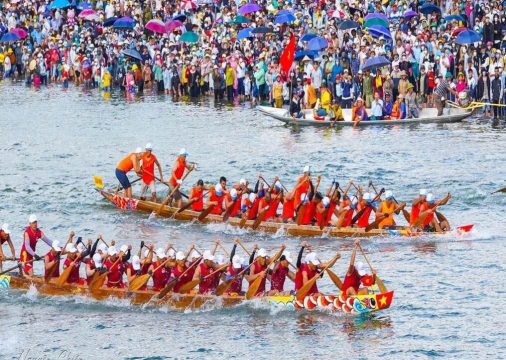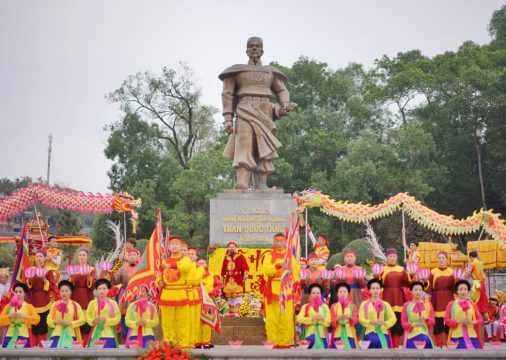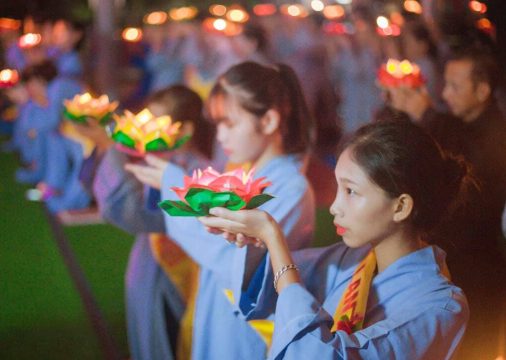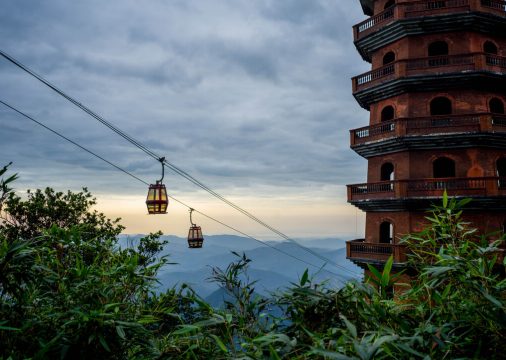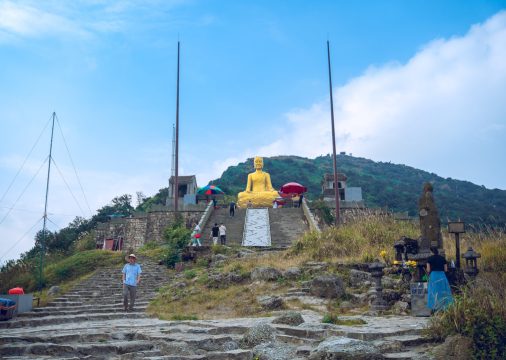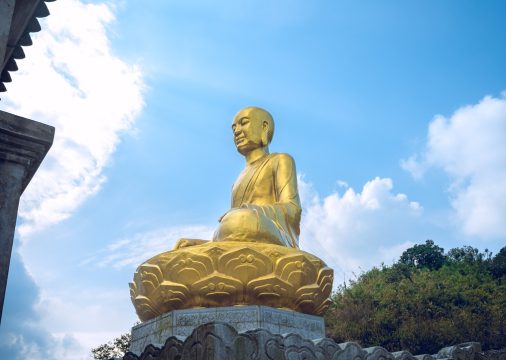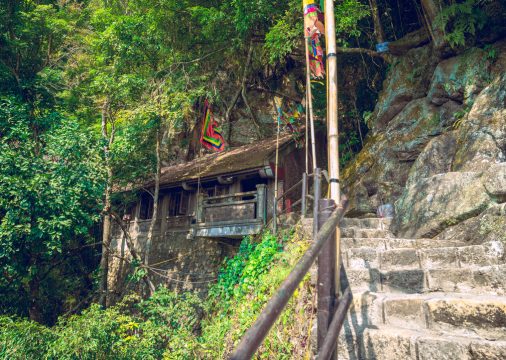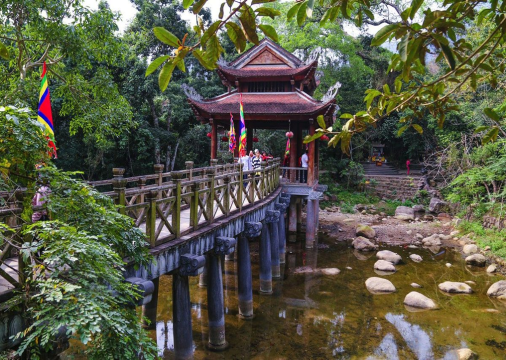Discover the History of Yen Tu Bronze Pagoda – A Sacred Mountain Pilgrimage
Discover the history of Dong Pagoda in Yen Tu and essential travel tips in this guide from Yen Tu Tung Lam. Explore the sacred journey to this spiritual site atop the holy mountain to enrich your itinerary with insightful information before visiting.
1. Overview of Dong Pagoda, Yen Tu
Dong Pagoda sits atop Yen Tu’s sacred peak at an altitude of 1,068 meters above sea level. It is a revered spiritual destination that attracts countless pilgrims and tourists. As a symbolic part of the Yen Tu complex, the pagoda holds deep cultural and religious significance in Vietnamese Buddhism.
Surrounded by majestic natural scenery, Dong Pagoda is not only a pilgrimage site but also a popular tourist attraction, welcoming millions of visitors each year. This unique architectural work is crafted entirely from bronze, standing solemnly amidst the mountains of Yen Tu.

2. History of Dong Pagoda – Formation and Development
The Dong Pagoda has gone through various historical phases, each contributing distinct imprints to its development as a remarkable spiritual structure. Let’s explore how it evolved through different periods.
2.1. Early History
According to historical records, Dong Pagoda was first built by a concubine of Lord Trinh during the Later Le Dynasty (17th century). Uniquely made of bronze, it stood apart from the traditional wooden pagodas common in Vietnam at the time. Initially, it was merely a small shrine, barely large enough to accommodate a single person inside.
In 1740 (Canh Than year), under King Le Canh Hung, a fierce storm damaged the structure. Exploiting this, vandals dismantled the remnants, leaving only column holes on the rock as evidence.
In winter 1930, Bui Thi My from Long Hoa Pagoda rebuilt Dong Pagoda using concrete reinforced with bronze. It was placed on a square stone slab, roughly head-height, at the original site.
In 1993, overseas Vietnamese Buddhist Nguyen Son Nam and fellow followers in the U.S. initiated the casting of a new pagoda in the shape of the Vietnamese letter “Đinh” – a common layout in Vietnamese temples, symbolizing a blooming lotus. The structure was positioned beside the old concrete pagoda from the early 20th century.

2.2. Major Restoration in 2006
A significant milestone in the development of Dong Pagoda took place on June 3, 2006. Led by Venerable Thich Thanh Quyet and the Dong Pagoda Project Management Board, a major restoration was initiated. The project was funded by local and overseas devotees, with architect Tran Quoc Tuan from the Institute for Conservation of Monuments in charge of the design.
After around eight months of construction, on January 30, 2007, Dong Pagoda was completed in its current form. The new pagoda was strategically positioned between the two earlier structures, resulting in a harmonious and sacred architectural ensemble.
3. How to Get to Dong Pagoda, Yen Tu
Dong Pagoda is located atop Yen Tu Mountain in Uong Bi City, Quang Ninh Province. Here’s how to reach this sacred destination:
3.1. From Hanoi to Yen Tu Foot
- By Coach: Take a bus from My Dinh, Giap Bat, or Yen Nghia stations to Uong Bi. Travel time is approximately 3–4 hours.
- By Private Vehicle: Drive along the Hanoi – Hai Phong Expressway, then follow National Route 18 to Uong Bi. The journey takes about 2.5–3 hours.
3.2. From the Foot of Yen Tu to Dong Pagoda
- By Cable Car: This is the most convenient and popular option. The ride includes two segments:
- Segment 1: From the base to Hoa Yen Pagoda
- Segment 2: From Mot Mai Pagoda to near Dong Pagoda
- Hiking: For adventure seekers, hiking is a rewarding option. The trail includes stops like Giai Oan Pagoda, Hoa Yen Pagoda, and Bao Sai Pagoda. Expect a 5–6-hour trek depending on fitness level.

Note: Regardless of using the cable car, visitors must hike the final 700–800 meters on stone steps along the mountain slope. At this elevation, air is thinner – walk slowly, rest when needed, and stay hydrated.
4. Unique Architectural Features of Dong Pagoda
4.1. The Largest Bronze Pagoda in Asia
Dong Pagoda impresses with its structure entirely cast in bronze, weighing up to 70 tons – making it the largest bronze pagoda in Asia. It covers nearly 20m², with dimensions of 4.6m (L) x 3.6m (W) x 3.35m (H).
The roof features traditional “mũi hài” tiles and four dragon-head corners, reminiscent of Tran Dynasty aesthetics. Bamboo-shaped balustrades, delicate reversed-leaf motifs, and floral engravings enhance its sacred and majestic appearance. The one-chamber, dual-roof structure faces southwest, symbolizing spiritual ascent and resilience against harsh mountain weather.
4.2. Enveloped in Mist Year-Round
Situated at 1,068 meters altitude, Dong Pagoda is often shrouded in mist, lending it a mystical, heavenly ambiance. Early mornings or cold-season visits reveal ethereal, cloud-kissed views, offering profound serenity.

4.3. Sacred Statues Inside the Pagoda
Inside Dong Pagoda are finely crafted statues including Buddha Shakyamuni and the three Truc Lam Patriarchs. Each statue stands 0.45m to 0.87m tall and sits on a lotus pedestal with ornate motifs (lotus, chrysanthemum, fig, curled leaf, water waves, etc.). Visitors are advised not to touch the statues to preserve these sacred artifacts.
- Buddha Shakyamuni: Depicted in a lotus position with a kasaya robe.
- First Patriarch – King Tran Nhan Tong: Meditating with “auspicious” posture, gazing downward in introspection.
- Second and Third Patriarchs – Phap Loa & Huyen Quang: Both seated in meditation with mudra gestures, clothed in monk robes.
5. Notable Events and Rituals at Dong Pagoda
5.1. Yen Tu Festival
The Yen Tu Festival is the most prominent annual spiritual event held at Dong Pagoda and across the Yen Tu complex. It runs from January to March (lunar calendar), attracting millions of pilgrims nationwide.
5.2. Ceremonies for Peace and Commemoration
Other significant rituals include ceremonies for peace, national prosperity, and commemorations of King Tran Nhan Tong – who renounced his throne to found Truc Lam Zen Buddhism. These events include chanting, offerings, and collective prayers, providing opportunities for spiritual reflection and cultural appreciation.

6. Essential Travel Tips for Visiting Dong Pagoda
- Attire: Dress modestly and respectfully.
- Bring a jacket: Temperatures at the summit are lower, especially in winter or misty days.
- Mind your steps: Natural stone terrain near the summit requires careful walking.
- Eco-consciousness: Do not litter or damage the environment.
- Respect the heritage: Avoid touching or damaging structures and statues.
- Maintain silence: Preserve the serene atmosphere inside the pagoda.
- Carry snacks and water: For energy during long treks.
- Be cautious when shopping: Avoid unknown-source souvenirs.
- Protect belongings: Keep valuables safe, especially during crowded festivals.

With these practical tips, we hope you enjoy a meaningful and memorable trip to Dong Pagoda, Yen Tu. This spiritual journey offers not only blessings and peace but also an immersive experience of Vietnam’s rich Buddhist heritage and natural beauty.
The history of Dong Pagoda reflects the intersection of spiritual devotion and the exquisite craftsmanship of Vietnamese artisans. Yen Tu Tung Lam hopes this guide helps you fully appreciate your visit to this extraordinary mountain sanctuary.








